This post may contain affiliate links. Please see our disclosure policy.
Canning figs at home is a simple way to preserve these sweet but perishable fruits.
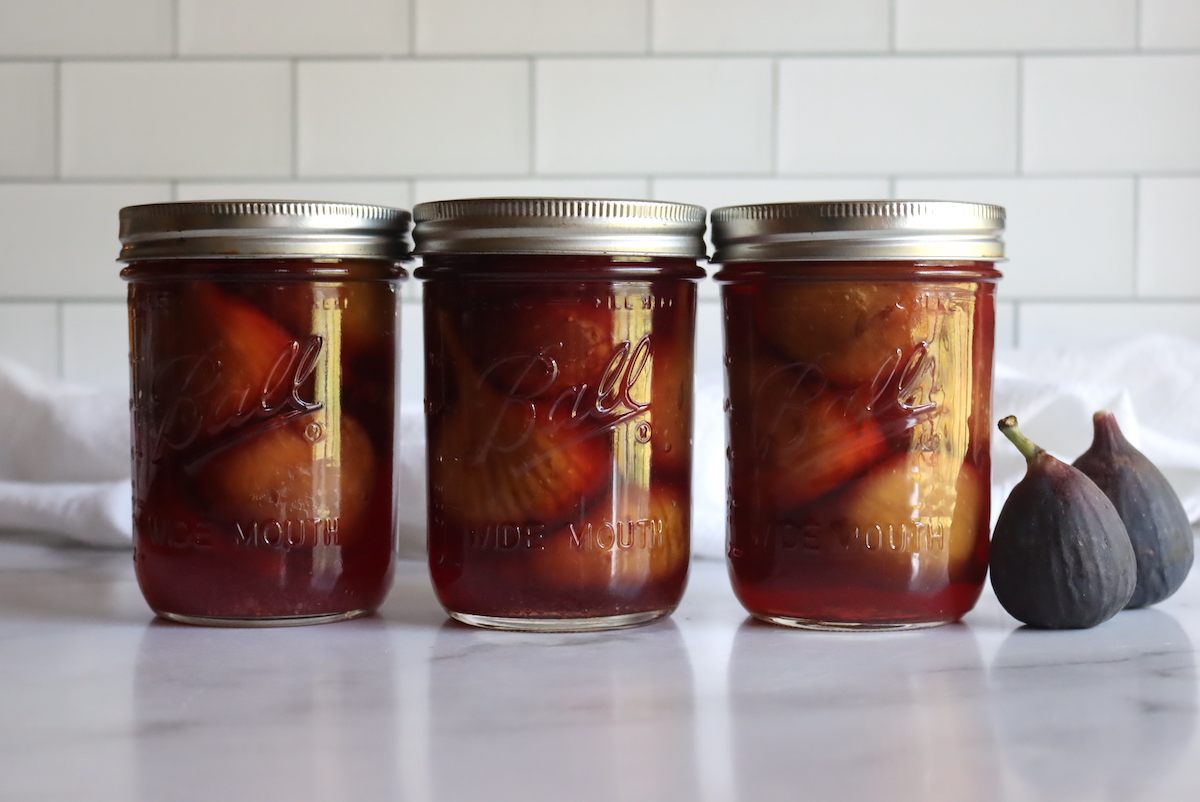
I grew up eating figs by the bucketload from my grandmother’s fig trees, and I know just how prolific fig trees can be. She had three large fig trees, and all the grandkids worked hard to eat up every last one in season…but we never succeeded.
Every year, she’d fill the freezer with figs, and eventually, they just rotted on the ground once she ran out of freezer space.
My grandmother wasn’t a canner, and she didn’t know just how easy it is to can figs at home in syrup. They’ll preserve right on the pantry shelf, staying sweet and delicious for year-round enjoyment.
Figs actually can beautifully, and they’re much better out of a canning jar than the freezer. They can be eaten with a fork right out of the syrup, or you can use them in baking recipes. They also make a great topping for ice cream or yogurt.
A single fig tree will yield more than enough for a family, so if you’re growing figs, it pays to learn how to can figs at home.
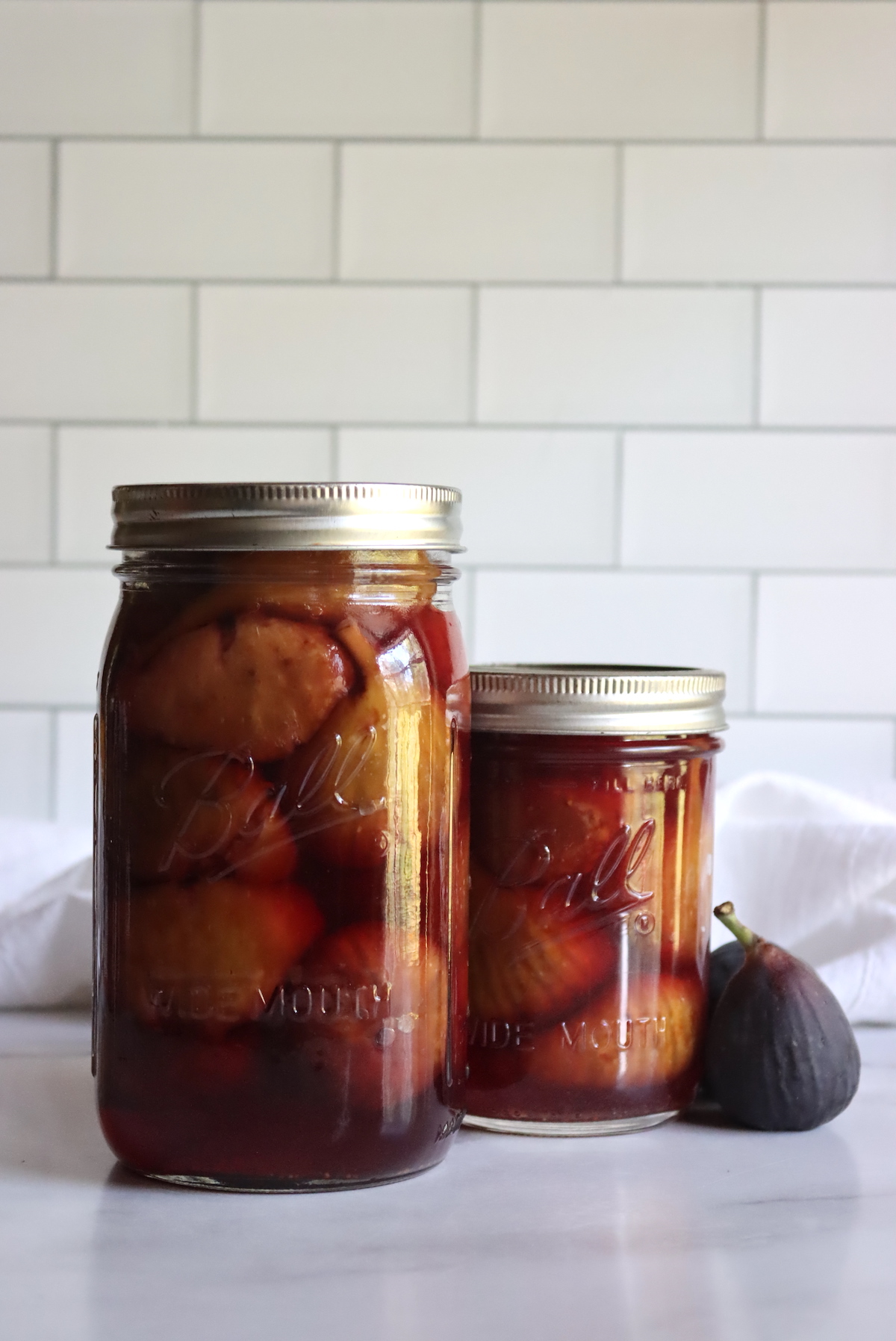
Canning Figs Yield
The total amount of figs needed to fill jars will depend on the size of your figs and how efficiently you’re able to pack the jars. They’re a hot pack, which makes it a bit trickier to pack the jars since they’ll be boiling hot when they go in. Still, since they’re hot-packed, they shrink a bit, so it’ll all work out.
Generally, it takes about 16 pounds of fresh figs to fill a canner load of 7 quarts or about 11 pounds for a 9-pint canner batch. That’s about 2 1/4 pounds per quart, or 1 1/4 pounds per pint.
If your figs are small, they’ll pack a bit tighter, and you’ll need slightly more to fill the jars. Similarly, very large figs won’t pack as well and will require a bit less.
Figs may be canned in quarts, pints, or half-pint jars. If using smaller half-pint jars, the processing times are the same as for pints. Do not can figs in jars larger than quarts.
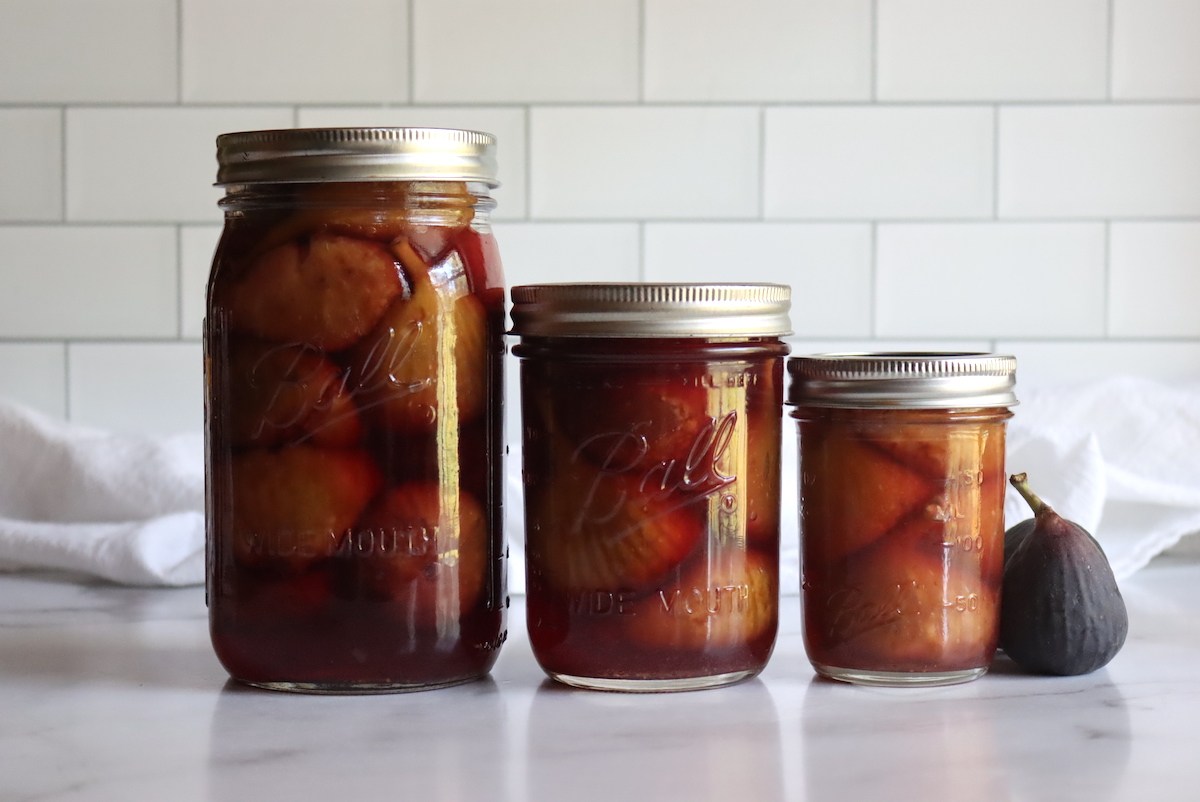
Preparing Figs for Canning
Figs are canned whole, and the process of preparing them for canning is relatively simple.
I know you’ll be tempted, but don’t cut off the fig stems before canning. They’ll bleed fig sap into the jars, which can impact the flavor of your home canned figs, and it’ll make the canning liquid cloudy. Leave the stems on and take them off at serving.
Don’t peel them either. Peeling will cause them to fall apart in the canner. Basically, you just give them a quick rinse, but don’t otherwise cut or trim them.
Figs need to be blanched before canning, which helps to remove some of the bitter agents in their sap and skin. Bring a pot of water to a hard boil and add the figs. Boil for 2 minutes, and then strain, discarding the cooking water.
Once the figs are blanched, it’s time to get ready for canning figs.

How to Can Figs
Prepare a water bath canner, along with jars, lids, and rings. Heat the canner to a gentle simmer (around 180 degrees F) for hot pack canning.
While the canner is heating, blanch the figs as described above. (Boil for 2 minutes, then discard the blanching water.)
Prepare a batch of light syrup for canning. You can use extra light syrup or medium or heavy syrup too. Generally, light syrup keeps them sweet and of best quality, but feel free to use whatever canning syrup strength you prefer. (There’s a guide to the measurements for each canning syrup here.)
To make light syrup for a canner batch of 9 pints, you’ll need:
- 5 3/4 cups water
- 1 1/2 cups sugar
That’s enough syrup to can about 11 pounds of figs in a 9-pint batch.
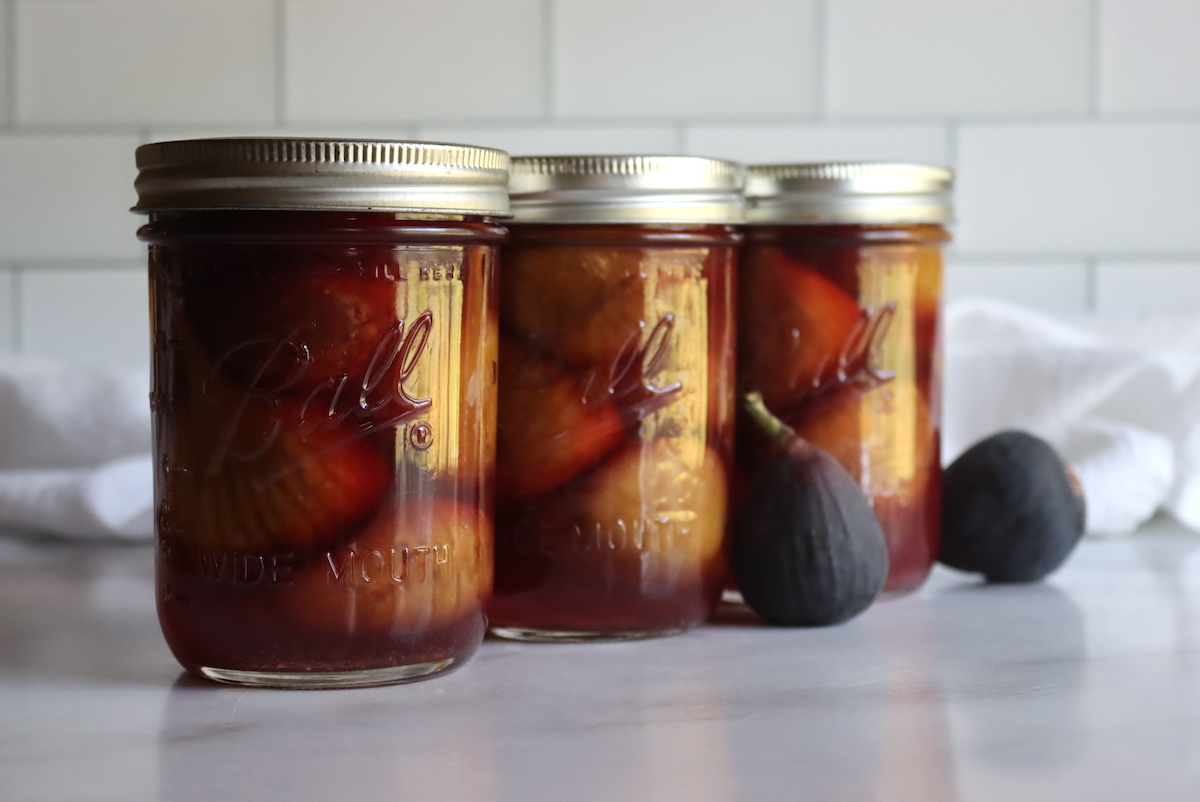
To make light syrup for a batch of 7 quarts, you’ll need:
- 9 cups water
- 2 1/4 cups sugar
That’s enough syrup to can about 16 pounds of figs in a 7-quart batch.
Mix the syrup in a large stock pot and bring it to a gentle boil on the stove. Add the blanched figs and cook them in the canning syrup for 5 minutes.
While the figs are cooking in the syrup, you’ll need to add lemon juice or citric acid to your canning jars. Don’t add the lemon juice to the boiling syrup. It’s important to get the measurements accurate per pint or quart, and the best way to do that is to add lemon juice or citric acid directly to the jars before filling them.
(Believe me, you want to do this before you add the figs, or you might forget and process the jars without the added acidity. If that happens, you’ll have to start over because they’re not safely canned without the added lemon juice or citric acid.)
Add 2 Tbsp. of bottled lemon juice per quart, or 1 tbsp per pint. If you’re using citric acid, you can use 1/2 tsp citric acid per quart or 1/4 tsp per pint.
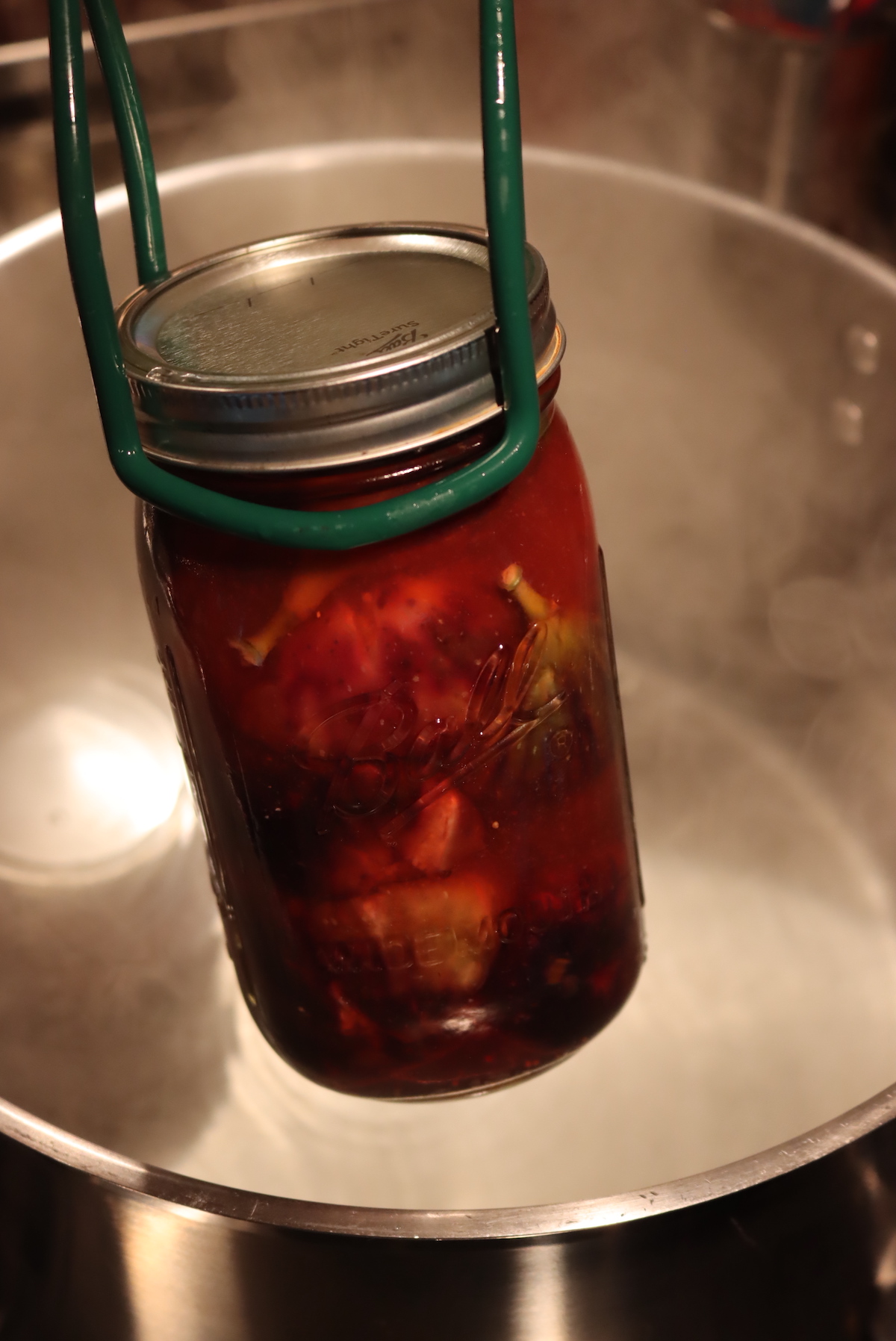
Gently ladle the hot syrup-boiled figs into prepared canning jars. It helps to use a slotted spoon to start with, then fill the jars the rest of the way with syrup.
Be sure to leave 1/2 inch headspace above the figs and syrup in the jars.
De-bubble jars and apply 2 part canning lids.
Process the figs in a water bath canner for 45 minutes for pints and 50 minutes for quarts (below 1,000 feet in elevation). For higher elevations, see the table below:

Fig Canning Recipes
Ways to Preserve Figs
Looking for more ways to preserve figs? While I think canning whole figs is the most versatile way to preserve figs at home, it’s not the only way:

Canning Figs
Equipment
Ingredients
For a 7 Quart Batch:
- 16 lbs fresh figs
- 9 cups water, plus more for blanching
- 2 1/4 cups sugar
- A scant cup of bottled lemon juice, 2 Tbsp per jar
For a 9 Pint Batch:
- 11 lbs fresh figs
- 5 3/4 cups water, plus more for blanching
- 1 1/2 cups sugar
- A bit more than half a cup bottled lemon juice, 1 Tbsp per jar
Instructions
- Prepare a water bath canner, jars, lids and rings before beginning. The canner should be pre-heated for hot pack to a gentle simmer, about 180 degrees F.
- Bring a pot of water to a boil on the stove and blanch the figs for 2 minutes. Drain and discard the blanching water.
- Add measured water and sugar to a stock pot and bring it to a boil. The measurements in this recipe make light syrup. See notes for other syrup types.
- Add blanched figs to the boiling syrup and boil for 5 minutes.
- While the figs are boiling in syrup, add lemon juice or citric acid directly to the empty canning jars. You'll need to add 2 Tbsp. of bottled lemon juice per quart, or 1 tbsp per pint. If you're using citric acid, you can use 1/2 tsp citric acid per quart or 1/4 tsp per pint.
- Use a slotted spoon to fill the canning jars with figs, and then ladle the canning syrup on top. Be sure to leave 1/2 inch headspace.
- Seal the jars with 2 part canning lids and process them in a water bath canner for 45 minutes for pints and 50 minutes for quarts (below 1000 feet in elevation). See notes for processing times for higher elevations.
- Once the processing time is complete, turn off the heat and allow the jars to sit in the canner for an additional 5-10 minutes. This partially cools the jars and helps prevent siphoning as the jars are removed from the canner. Use a jar lifter to remove the jars to cool on a towel on the counter.
- Check seals after 12-24 hours. Store any unsealed jars in the refrigerator for immediate use. Properly canned and sealed jars will keep on the pantry shelf for 12-18 months.
Notes
- For 0 to 1,000 Feet – 45 min for pints and 50 min for quarts
- For 1,001 to 3,000 Feet – 50 min for pints and 55 min for quarts
- For 3,001 to 6,000 Feet – 55 min for pints and 60 min for quarts
- Above 6,001 Feet – 60 min for pints and 65 min for quarts
- For extra light syrup, use 6 1/2 cups water and 3/4 cup sugar
- For light syrup, use 5 3/4 cups water and 1 1/2 cups sugar
- For medium syrup, use 5 1/4 cups water and 2 1/4 cups sugar
- For heavy syrup, use 5 cups water and 3 1/4 cups sugar
- For extra heavy syrup, use 4 1/4 cups water and 4 1/4 cups sugar
- For extra light syrup, use 10 1/2 cups water and 1 1/4 cups sugar
- For light syrup, use 9 cups water and 2 1/4 cups sugar
- For medium syrup, use 8 1/4 cups water and 3 3/4 cups sugar
- For heavy syrup, use 7 3/4 cups water and 5 1/4 cups sugar
- For extra heavy syrup, use 6 1/2 cups water and 6 3/4 cups sugar
Nutrition
Nutrition information is automatically calculated, so should only be used as an approximation.
Fig Canning Recipes
Canning whole figs is just one way to put them into a canning jar. Try jams, jellies, syrups, and more!
- Fig Jam
- Fig Jelly (coming soon)
- Fig Syrup (coming soon)
- Pickled Figs
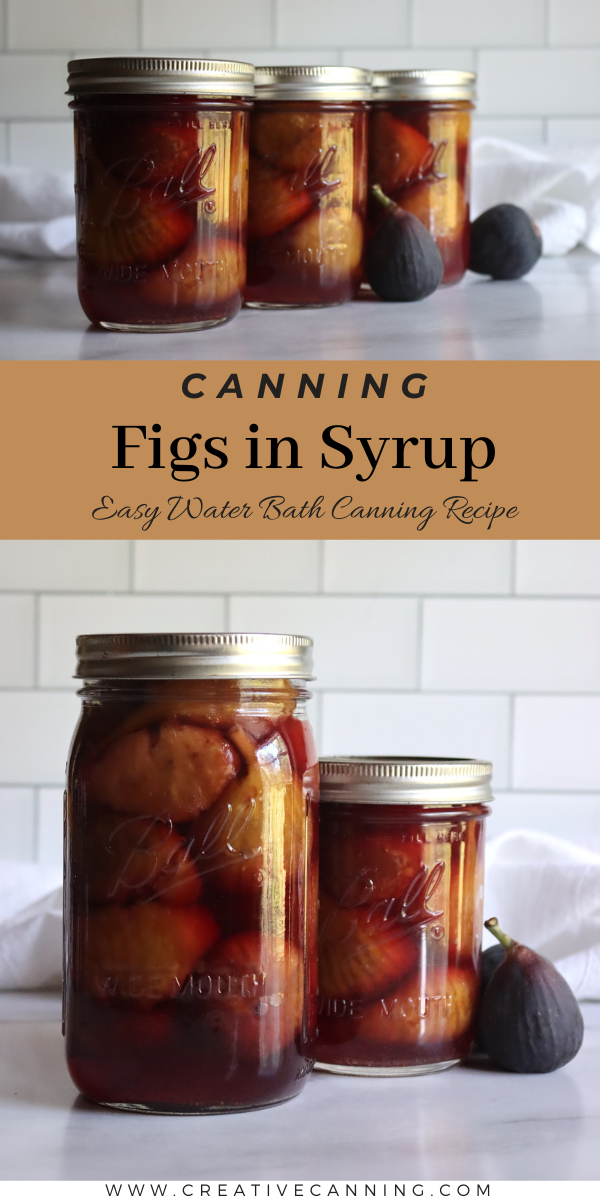
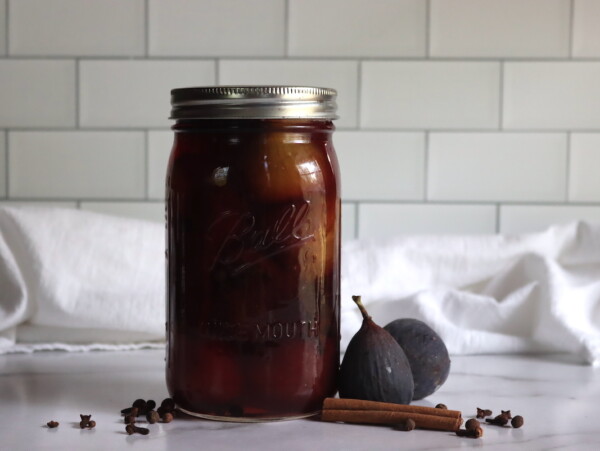
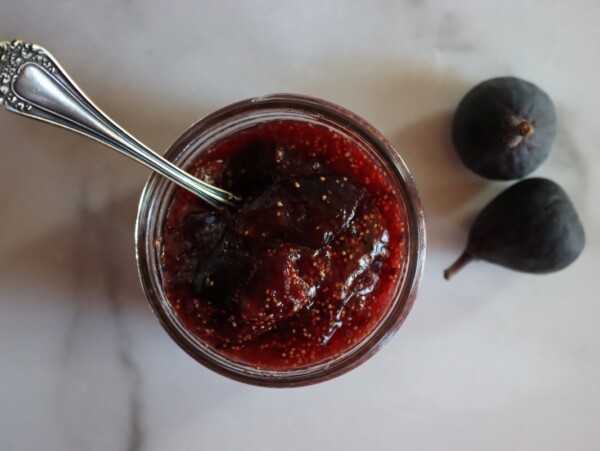
Hi Ashley, I canned figs in light syrup earlier this year. Can I now make fig preserves from them? And if so what recipe would work?
You can use this recipe from the NCHFP. They’re using 4 cups sugar to 6 cups water for the recipe. A light syrup is 1 1/2 cups sugar to about 6 cups water, so you’ll drain the figs and add a good bit more sugar to the syrup. They’re already pre-cooked, so you can skip the blanching steps. Best of luck!
Hello,
Please can you tell me whether one can can figs that have been cut into pieces rather than canning them whole?
Thank you for your help.
Regards,
Michele.
Hmmm…good question. So you can put up fig jam just fine (which is chopped) and fig preserves, and chopped figs in a jar would be kind of an intermediate step between whole figs and jam. The main issue is that the figs might fall apart in the jar that way, and create a thicker mixture. You also can fit more figs in a jar when they’re chopped, so it’s possible you might need more lemon juice.
There is not a specifically tested method for this, so you’ll have to use your best judgement here.
If I wanted to do it, I’d increase the lemon juice to 1.5 to 2x the normal amount and then make sure I don’t over pack the jars. That said, that’s just a guess, and since it hasn’t been tested you’ll have to use your best judgement.
You can also just can them whole, and then chop them when they come out of the jars.
Ahhh…I see now you have a comment in another post explaining why you want to chop them. I’ll put that here so others can see if they have the same question. Again, there’s not a tested method, but that is a darn good reason to want to slice them.
”
Hello,
Please can you tell me if you can can chopped figs like whole ones?
I live in France and this year for the first time, we have been visited by the black fig fly. Usually I bottle our figs but this year when I bottled the first batch, larvae floated to the top of the syrup in the bottles – somewhat disconcerting!
So I wondered about cutting up the figs to see which one had been attacked.
Thank you for your help.
Regards,
Michele Bland.